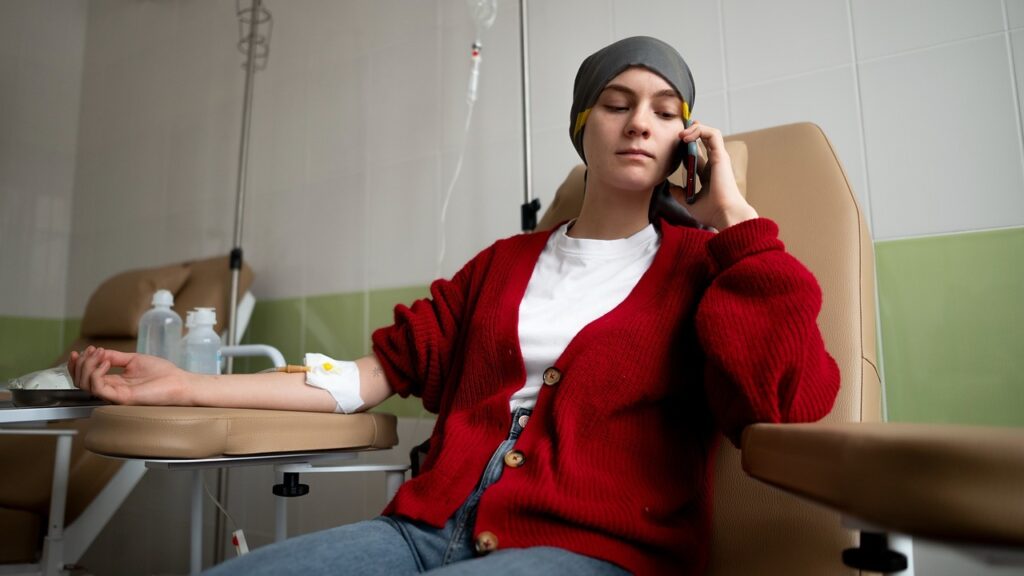Last Updated on November 3, 2025 by mcelik

At Liv Hospital, we’re dedicated to top-notch care for Acute Myeloid Leukemia (AML) patients. As 2025 approaches, AML treatment is changing fast. New therapies and targeted treatments bring hope to patients.
We aim to create personalized chemotherapy plans for each patient. We use the latest in cancer treatment, like CAR-T cell therapy. We also focus on how the immune system fights leukemia.
We’re always updating our care to match the latest research. This ensures our patients get the best care possible.

It’s important for both patients and doctors to know about Acute Myeloid Leukemia (AML). AML is a serious disease where abnormal white blood cells grow too fast. These cells stop the bone marrow from making healthy blood cells.
AML starts with a genetic change in a blood-making cell. This leads to too many immature cells, called blasts, in the bone marrow and blood. These abnormal cells take over, making it hard for the bone marrow to make normal blood cells.
There are several things that can increase your risk of getting AML. These include being exposed to harmful chemicals, having radiation therapy, or getting chemotherapy before. Being older also raises your risk, with most cases happening in people over 60.
| Risk Factor | Description |
|---|---|
| Chemical Exposure | Being around certain chemicals, like benzene, can raise your risk of AML. |
| Radiation Therapy | Having had radiation therapy, mainly at high doses, can increase your risk of AML. |
| Age | Getting older increases your risk of AML, with most cases in people over 60. |
The symptoms of AML can vary but often include feeling very tired, losing weight, getting sick a lot, and bleeding easily. Spotting these signs early is key for getting the right treatment fast.
Knowing about AML helps patients and doctors work together. This leads to better care and treatment plans.

Diagnosing Acute Myeloid Leukemia (AML) is a detailed process. It involves many tests and procedures. Getting the diagnosis right is key to creating a good treatment plan.
Doctors use bone marrow biopsies and blood tests to find AML. These tools help spot leukemia cells and figure out the AML type.
AML gets classified using systems like the French-American-British (FAB) classification and the World Health Organization (WHO) classification. These systems sort AML into subtypes based on cell type and genetics.
Genetic testing is critical in AML diagnosis. It finds specific genetic mutations that guide treatment. Epigenetic modifications also affect cancer growth, making them therapy targets. Custom chemotherapy plans are vital for treating AML well.
AML treatment needs a team of experts. AML patients get a care plan that fits their needs. Our team works hard to help AML patients get the best care.
Hematologists and oncologists are key in AML treatment. They have a lot of experience with AML. Hematologists know a lot about blood disorders. Oncologists focus on cancer treatment. Together, they make sure AML patients get the care they need.
Oncology nurses are important in AML care. They help during chemotherapy and check on patients. Compassionate nursing care helps patients deal with AML treatment.
Other experts also help with AML care. Nutritionists, social workers, and mental health professionals help with emotional and practical needs.
Our team works together to give AML patients the best care. They support patients every step of the way.
Chemotherapy is key in treating AML. It comes in different types, each suited for a patient’s needs. Studies show it works well against AML.
Intravenous chemotherapy puts drugs straight into the blood. This method gets the drugs to cancer cells more effectively.
The “7+3” regimen is a common treatment for AML. It mixes cytarabine with an anthracycline. The exact treatment depends on the patient and doctor’s decision.
Oral chemotherapy pills are an easier option for some. They can be taken at home, cutting down on hospital visits.
AML treatment has three main phases: induction, consolidation, and maintenance. Induction aims to kill as many leukemia cells as possible.
| Treatment Phase | Goal | Typical Chemotherapy Used |
|---|---|---|
| Induction | Achieve remission | Cytarabine and Anthracycline |
| Consolidation | Kill remaining leukemia cells | High-dose Cytarabine |
| Maintenance | Prevent relapse | Oral chemotherapy or targeted therapy |
Knowing about AML treatment phases and chemotherapy’s role helps patients understand their journey better.
AML treatment often uses a mix of chemotherapy drugs. Cytarabine and anthracyclines are key players. They’ve been mainstays in AML treatment for years, with their use getting better over time.
Cytarabine stops leukemia cells from growing by messing with DNA. Anthracyclines, like daunorubicin and idarubicin, also target leukemia cells. They damage DNA and kill cells.
Combining chemotherapy drugs is a common AML treatment approach. It attacks leukemia cells from all sides, lowering resistance chances. A well-known combo is the “7+3” regimen, where cytarabine and an anthracycline are given for 7 and 3 days, respectively.
Dosing strategies aim to be effective yet safe. High-dose cytarabine is used in consolidation therapy to kill off leukemia cells. For more on leukemia treatment, check out this resource.
The exact dosing and timing of chemotherapy depend on several factors. These include the patient’s age, health, and how they respond to treatment. Our medical team takes these into account when planning treatment.
The time AML chemotherapy lasts can change a lot. This depends on how well the patient responds. It can be tough for patients and their families to deal with this uncertainty.
Many things can change how long AML chemotherapy lasts. These include:
For example, how well the immune system works, like natural killer (NK) cell activity, can really affect treatment results.
AML chemotherapy goes through different phases. These are induction, consolidation, and maintenance. The schedule can vary, but usually:
After the first treatment phases, patients need ongoing care. This is to watch for relapse and manage long-term side effects. This care is key for the best results.
We know every patient’s fight with AML is different. Our team is dedicated to giving personalized care and support during treatment.
AML treatment saves lives but comes with tough side effects. It’s key to tackle these side effects well to help patients get the best results.
Side effects of AML treatment include nausea, tiredness, hair loss, and more infections. Managing these side effects is vital for patients’ quality of life. For example, anti-nausea meds can help with nausea. Fatigue can be managed with rest, good nutrition, and light exercise.
AML treatment weakens the immune system, raising infection risks. Prophylactic antibiotics and antifungal meds may be used to lower this risk. It’s important to watch for infections closely and treat them quickly.
“The risk of infection is a major concern for patients undergoing AML treatment. Proactive measures and vigilant monitoring are essential to prevent and manage infections effectively.”
Expert Opinion
Supportive care is key in handling AML treatment side effects. This includes nutrition, pain control, and mental health support. A team of experts works together to care for all aspects of a patient’s health.
By focusing on side effect management and supportive care, we can make AML treatment better for patients. Improving supportive care is essential for better patient outcomes and quality of life.
In 2025, AML treatments are getting more advanced. We’re seeing a big change in how AML is treated. This includes targeted therapies, immunotherapy, and precision medicine.
Targeted therapies have changed AML treatment a lot. FLT3 inhibitors like midostaurin and gilteritinib are showing great promise. IDH inhibitors such as ivosidenib and enasidenib target IDH1 and IDH2 mutations. BCL-2 inhibitors like venetoclax are also effective, often when used with other treatments.
Immunotherapy is making big strides in AML treatment. We’re looking into CAR-T cell therapy and other immunotherapies. These include checkpoint inhibitors and bispecific antibodies.
Precision medicine is changing AML treatment. It tailors therapies to each patient based on their genes. This helps find the best treatments and reduces side effects.
Personalized treatment plans use genetic info to guide decisions. By looking at a patient’s genes, we can pick the best therapies. This makes treatment more effective.
Biomarker-driven therapy is key in precision medicine for AML. It helps us choose the right treatments for each patient. This is based on genetic markers.
2025 is a key year in the fight against AML. New therapies and research breakthroughs bring hope. We see big steps forward in treatments that could cure AML.
CAR T-cell therapy is a new hope for AML. It changes a patient’s T-cells to fight cancer. Recent studies show promising results, with some patients getting complete remission.
“CAR T-cell therapy is a game-changer for AML treatment,” says -Dr. a top hematologist. “It offers a chance for a cure for those who’ve tried other treatments and failed.”
Research is also focusing on new drug combinations. These pair targeted therapies with traditional chemotherapy. These combos could lead to better response rates and survival.
Getting rid of minimal residual disease (MRD) is key for long-term remission. Researchers are finding new ways to detect and remove MRD.
New monitoring tools, like next-generation sequencing, help find MRD better. This lets doctors track how well treatments are working and how the disease is changing.
It’s important to know how well treatments are working. Researchers are working on better ways to check this. This helps doctors make the right decisions about treatment.
We’re excited about the progress in AML research. These breakthroughs could lead to better outcomes for AML patients. The dream of an AML cure is getting closer, and we’re here to support patients every step of the way.
Stem cell transplantation is a key treatment for Acute Myeloid Leukemia (AML) patients. It brings new hope with each advancement. These changes are making treatments better and opening up new options.
There are two main types of stem cell transplants: allogeneic and autologous. Allogeneic transplants use stem cells from a donor, like a family member or an unrelated donor. This type can help fight cancer cells. On the other hand, autologous transplants use the patient’s own stem cells. This lowers the risk of GVHD but might increase the chance of cancer coming back.
Reduced-intensity conditioning (RIC) regimens are a big help, mainly for older patients or those with health issues. They use lower doses of chemotherapy and/or radiation. This makes the treatment safer while helping the donor stem cells work.
After the transplant, post-transplant maintenance therapies are key to stopping cancer from coming back. These might include special drugs, immunotherapies, or new treatments. Researchers are working hard to find the best ways to keep AML patients healthy long-term.
When dealing with Acute Myeloid Leukemia (AML) treatment, patients face many choices. These include traditional chemotherapy, advanced targeted therapies, and stem cell transplants. We help international patients understand these options, guiding them in their care decisions.
The outlook for AML treatment is bright, thanks to ongoing research. New therapies like CAR T-cell treatment and drug combinations are being tested. These advancements mean better treatment options for patients, tailored to their needs.
We at our institution are dedicated to top-notch healthcare for international patients. We combine medical skill with caring support, helping patients face their AML treatment journey with confidence. As AML treatment evolves, we stay ready to offer the latest and most effective treatments, bringing hope and strength to those affected.
AML is a cancer that starts in the bone marrow and spreads to the blood. It happens when the bone marrow makes bad white blood cells. These cells fill the bone marrow and stop normal blood cells from being made.
Certain chemicals, radiation, and some chemotherapy can increase your risk of AML. Genetic disorders and past blood disorders also raise your risk.
Symptoms of AML include feeling very tired, losing weight, and getting sick often. You might also bruise easily, bleed a lot, or have trouble breathing. Some people feel pain in their bones or joints.
Doctors use blood tests, bone marrow biopsies, and genetic tests to find AML. These tests check for leukemia cells, the type of leukemia, and how far it has spread.
Genetic testing is key in diagnosing AML. It finds specific genetic mutations. This helps doctors decide on treatment and predict how well you’ll do.
A team of doctors, nurses, and specialists treat AML. They work together to give you the best care and support during treatment.
Doctors often start with chemotherapy for AML. This can be given through a vein or by mouth. The treatment plan depends on your health and the disease’s details.
Cytarabine and anthracyclines are common drugs for AML. They might be used alone or with other treatments.
How long you’ll have chemotherapy for AML varies. It depends on how well you respond and the treatment plan. Treatment can last months to years, and you’ll need ongoing check-ups.
In 2025, new treatments for AML include targeted therapies and immunotherapy. These aim at specific genetic changes or disease features.
Stem cell transplantation is a treatment for AML. It replaces your bone marrow with healthy stem cells. The choice between allogeneic or autologous transplants depends on your health and donor availability.
AML treatment can cause side effects like nausea, fatigue, hair loss, and infections. Supportive care, including medicines and nutrition, helps manage these.
Research focuses on new targeted therapies and improving treatments. Immunotherapy and precision medicine are also being explored. CAR-T cell therapy and new drug combinations show promise.
Patients can work with their healthcare team and stay updated on research. Support from loved ones and groups also helps.
Subscribe to our e-newsletter to stay informed about the latest innovations in the world of health and exclusive offers!
WhatsApp us